Yohei Fukuda bespoke shoes: The style and shop today
Yohei Fukuda is one of the finest shoemakers in the world. And given his longevity - he set up on his own 12 years ago - he’s been at the forefront of Japan emerging as the primary world force in bespoke.
But like many Japanese, it's taken him a while to feel he is as good as the masters he trained under. And in parallel, to feel it was OK to just be a Japanese maker, with a Japanese style.
Yohei and I talked recently about this and the many other changes he’s seen in those 12 years - ahead of a full review of a pair of bespoke shoes he made for me.
He is also coming to the UK for his first official trunk show later this year, in June or July.
At the Japanese Symposium in Tokyo last year, which I chaired, local artisans asked repeatedly about their reputation around the rest of the world. They couldn’t quite believe that they were considered on the same level as those in Europe.
Partly that’s because Japanese customers also still look to the West as the source of all top-end craft. And local fashion magazines echo that attitude.
It has only been as more Japanese have experienced both local and international makers - according to Yohei - that the attitude has started to change for bespoke shoes.
“At this point, many local customers have had shoes made in Europe, and from at least one Japanese maker,” he says. “They can see and compare themselves."
“Also, they start to tend towards local makers when they need shoes repaired, or perhaps stretched. It’s a lot more convenient to do that with someone local, rather than travel to Europe, and have to explain any issues in a different language.”
Yohei worked at George Cleverley and at Edward Green in the UK, and his house style is still clearly influenced by English traditions.
You can see echoes of Cleverley in the house-style square-toed oxford (below), and his shoes have never been as elongated or stylised as those of Japanese makers trained in Italy or France.
But his style has also evolved over the past 12 years, and now feels more his own. “When I first started it was just me at home, doing everything myself,” he says. “It was hard to feel then that I was trying to do anything other than replicate what I had learned in England."
“But I’ve gradually found what I like, and had more confidence in it. For example, I used to make very narrow waists on my shoes. They’re still quite narrow - more than most makers - but a little softer, more gentle. I don’t think there’s anything aggressive about what I make now.”
As ever with shoemaking, we’re talking about very small adjustments. A millimetre here or there. The waists of my shoes will still look very narrow to most readers, and Yohei says most of the changes are never noticed by customers.
“The samples I have on display are still the same ones that I made for my first shop 12 years ago,” he says. “I can see the differences - particularly in the proportions - but customers don’t really.”
Having started on his own, at home, Yohei’s first break came when a local watch store asked to put his shoes on display. “A journalist friend of mine wrote about them in a fashion magazine, and soon a lot of fashion people were coming down to take a look,” he says.
Unusually, those shoes were offered made-to-order, not bespoke.
When shoemakers set up on their own, they usually start by just offering bespoke. It is what they've been taught, and is perhaps most prestigious. It’s only later on, when they become bigger and there's demand for a cheaper (and quicker) product, that they offer RTW or MTO.
But Yohei wanted to offer just made-to-order shoes, to set himself apart. “Other makers offered bespoke - including the Europeans when they came to Japan for trunk shows,” he says. “So I wanted to do something different, to make shoes at the same quality level as bespoke, but without the bespoke fitting.”
This worked well for a while, until customers started wanting second and third pairs. These were usually for more unusual styles of shoes, perhaps with some fitting adjustments. So Yohei started offering bespoke as well.
Today, Yohei offers RTW shoes (The Armoury, The Sabot), MTO and bespoke.
There is no ‘personalised last’ or semi-bespoke (although this was offered for a while) because Yohei found it was hard to stop that slipping into full bespoke. The expectations were too high.
Instead, he offers different levels of MTO and bespoke depending on the design of the shoe - which reflects the extra time required in the workshop.
So there is MTO A, B, C and D, with A being the house-style oxfords, B some derbies and a whole cut, C adding a chukka boot and a chelsea boot, and D a jodhpur boot (below). Bespoke has house oxfords and full bespoke (where any design is possible).
The other big change after 12 years is that Yohei is no longer on his own.
His cosy first-floor studio and workshop in Tokyo contains four shoemakers apart from himself, which I’ve visited twice in the past four years (the photos here were taken in 2016).
Yohei still does all the lastmaking, and some pattern cutting, but most of the other work is done by his shoemakers. “The lastmaking is the most important, because that can undermine everything,” he says. “Everything else can be fixed, but if the last is wrong, the shoe cannot work.”
Between them, the team can make about 100 bespoke pairs of shoes a year, for about 60 clients (some order more than one).
That’s not a lot for someone with as big a reputation as Yohei’s, and offering RTW was also important for him as a way to expand awareness of the shoes.
“The only way for people to know bespoke shoemaking - to help preserve the tradition and the skills - is for more people to experience them,” he says. “So with RTW they can feel the quality, the style, the lightness. It’s also a good way to employ more shoemakers here, and spread the craft that way.”
This increased awareness will also, hopefully, help both Japanese and international customers realise the quality coming out of Japan.
That might seem obvious to menswear fans that read Permanent Style, but in the broader market, bigger, more storied houses in Europe are still much better known - something that stayed with me long after the Symposium last year.
Hopefully this coverage and Yohei’s forthcoming trunk show in London will help a little bit too.
Yohei currently holds trunk shows in Hong Kong and New York (through The Armoury), Beijing, Shanghai, Singapore and Paris. He also takes RTW shoes to certain countries for three months at a time, like a rolling pop-up shop. Contact Yohei for details.
Prices and delivery times currently are:
- Ready to wear: 240,000 Yen (£1,700, $2,200)
- Made to order A: 270,000 Yen, three to four months (same for all MTO)
- Made to order B: 300,000 Yen
- Made to order C: 330,000 Yen
- Made to order D: 360,000 Yen
- House style bespoke: 420,000 Yen, eighteen months (same for all bespoke)
- Heritage style bespoke: 440,000 Yen
- Full bespoke: 500,000 Yen
Photography: Jamie Ferguson, except that of finished shoes, Yohei Fukuda
Review of my bespoke shoes next week


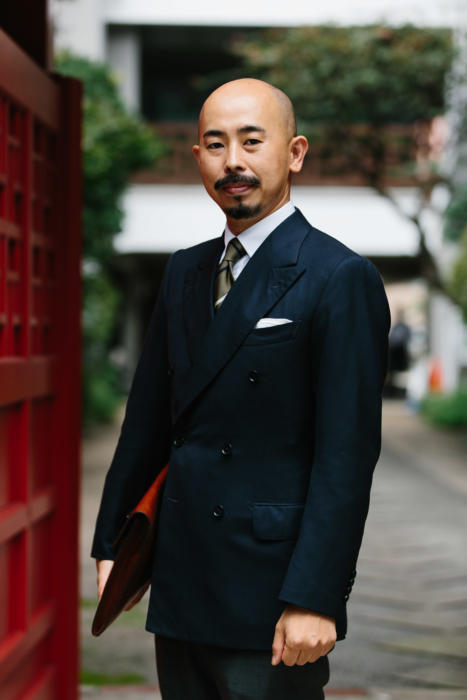
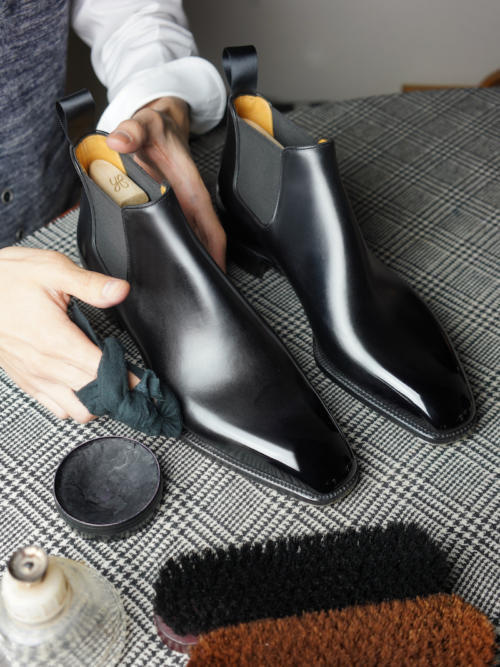
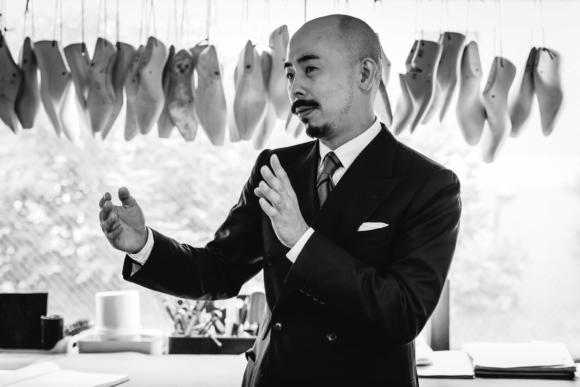
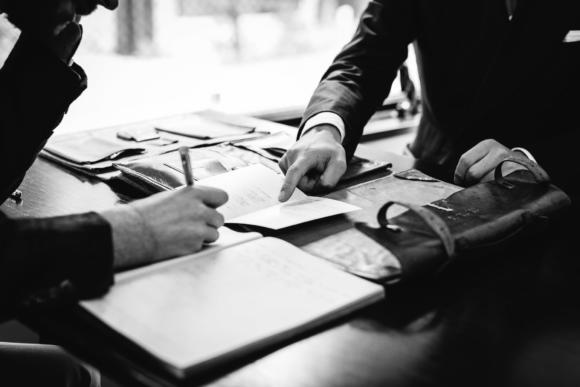
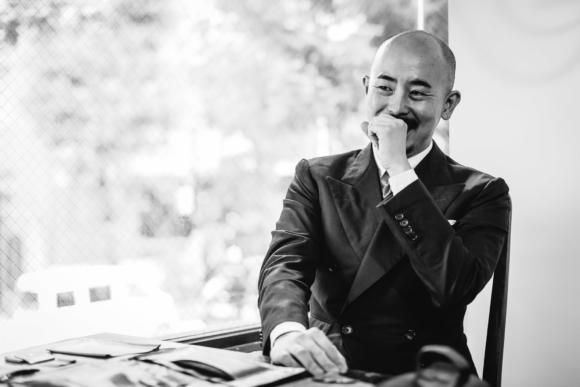
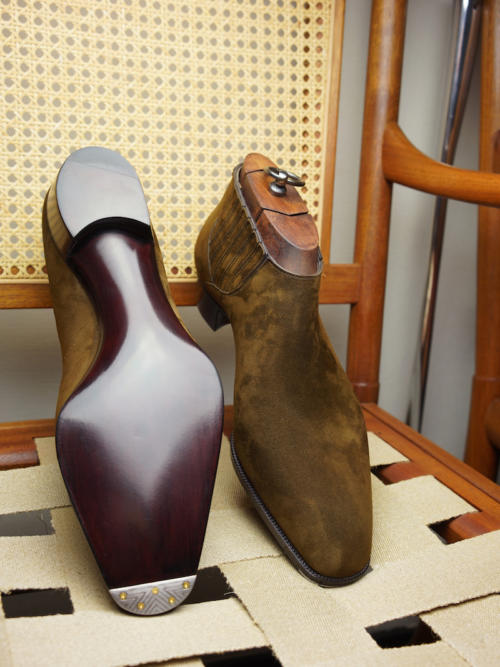
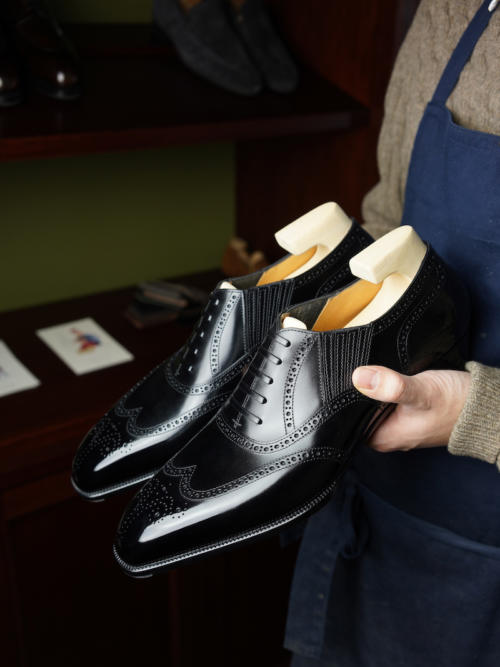
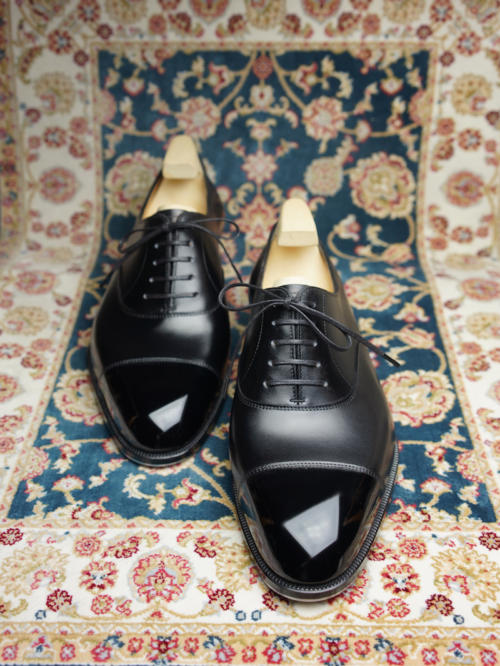
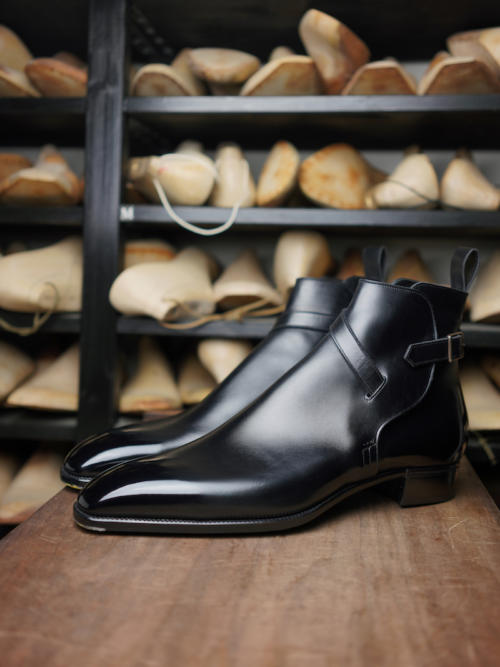
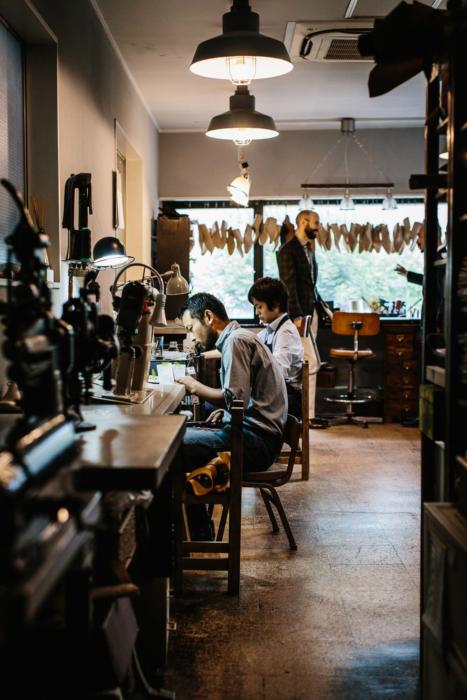
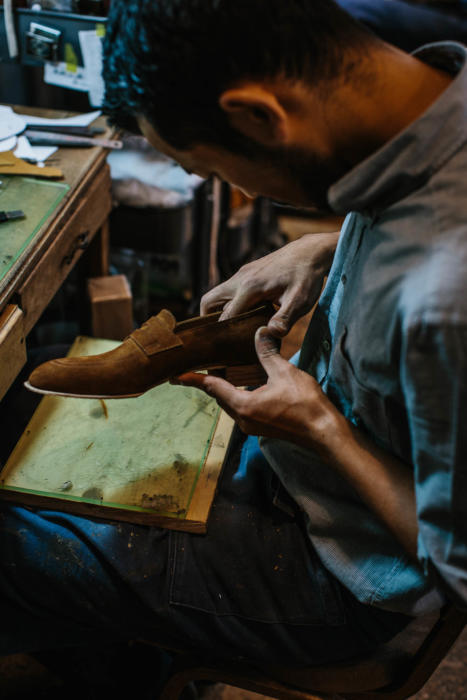
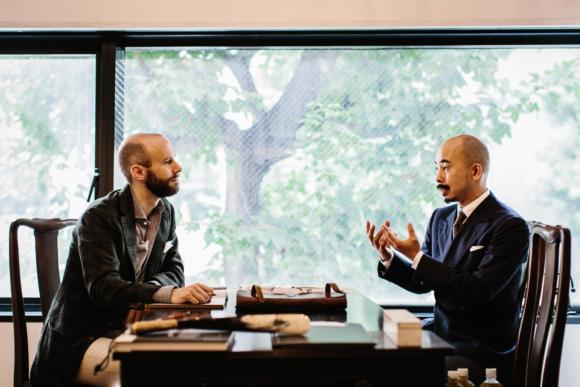
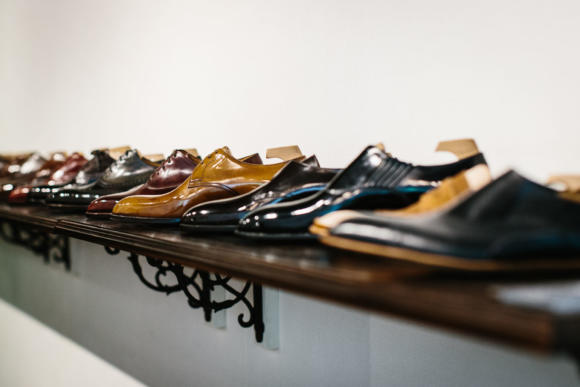
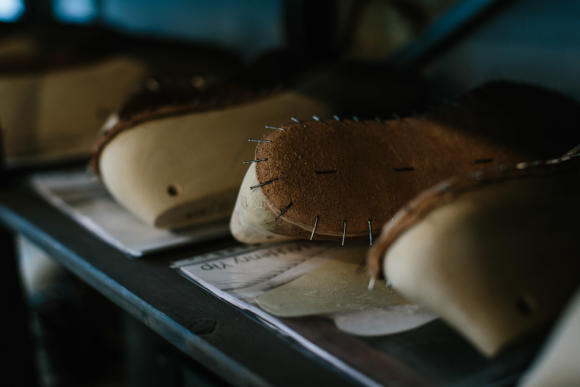
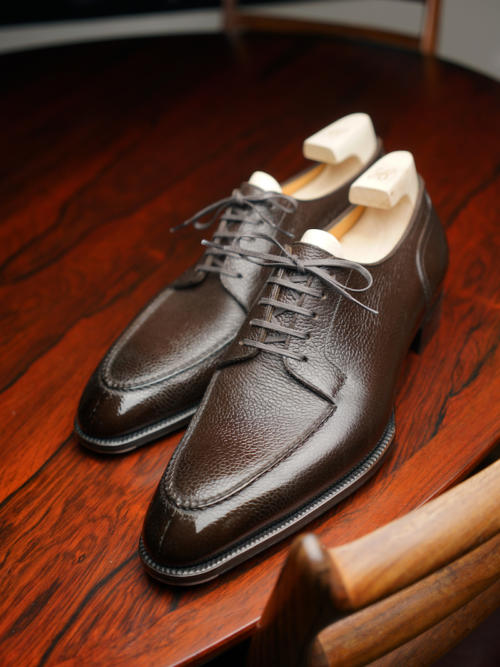
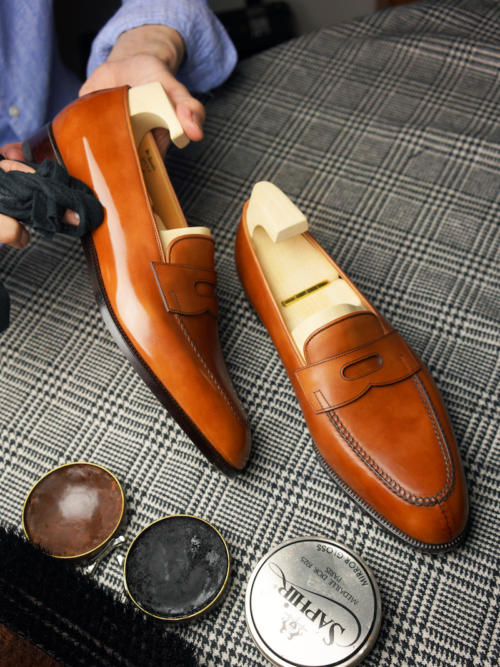
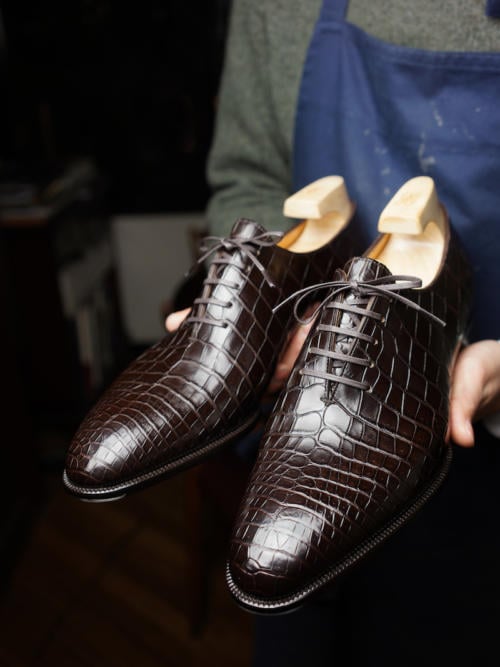


























Thank you very much Simon! Is the quality of production the same in bespoke as well as RTW? Also, I was wondering if you tried the RTW and if yes, what you thought of the fit? I am asking because I’ve heard from some producers that what suits Asian feet or shoulders, doesn’t always fit the mass European market.
Yes it is the same, and I have tried the RTW – at The Armoury.
I’d say the fit is pretty similar to English makes, not Japanese ones. It was a decent fit, but had similar issues to other RTW oxfords from English makers (my narrow ankle, compared to wide joints)
Glad you’re covering more japanese makers. A lot of them seem to have higher standards than makers in the west, better photography and unbelivable finish. It was something I feel the page lacked. Hopefully you can cover Eji Murata, Seji McCarthy or Koji Suzuki (Spigola).
Thanks Fernando. I’ll do my best
Mr. Crompton,
Can you make a post like the one you did on shirts (the 21 shirtmakers I have known) on shoes?
There is a lot I wonder about. And I could need advices about brands and RTW versus bespoke. I usually buy my shoes at Cleverly. But is the quality at fex Edward Green better? They seem to be much more expensive.
OK, sure Rune. I have done one on bespoke makers, but it does need updating with Yohei and Masaru.
A broader one on shoe brands would only offer brief summaries and links to my coverage of all the shoemakers, but I guess it would also be a good place to ask comparative questions like this.
The standard ready-to-wear shoes from Cleverley are not as good as Edward Green, no. They’re made by Crockett & Jones and are around the same level of quality.
And who would you say have the best RTW shoes?
A question as well is if bespoke shoes are worth the (very much) higher price than a good quality RTW?
They’re both very big questions Rune, and not really possible to answer in a comment alone.
However, with most RTW shoes, the more expensive are the higher quality, unless you go to a designer brand. So the highest quality level will be the RTW shoes that some bespoke makers offer which are made to the same quality as bespoke – such as Fukuda RTW or Stefano Bemer Tradizione (see separate conversation below).
The hard question with RTW is not really which are the best quality, but which are the best value, and which level you should go to in spending your money.
On the worth of bespoke, it’s a big question, but as a very broad statement I’d say the fit isn’t worth it unless you’re prepared to buy more than one bespoke shoe, and so invest in the process for a while (see comment in my post above).
Is Fukuda RTW obtainable in London?
Not in a shop, no
Dear Simon,
Do you think the semi-bespoke line “Anthony Cleverley” from G Cleverley is also not as good as EG?
Kind regards
I haven’t tried it, so can’t really say with any experience. But my understanding is they were made by Crocketts to their handgrade level, so no they wouldn’t be as good
I was looking for boots in shell cordovan from Crockett & Jones for £ 810 (Harleck) and Edward Green boots for a bit more than twice the price from the same material, both sourced from Horween, I inspected very carefully, and I don’t see why to expend twice for almost the same product. Mind you I’m not expert, just try to be pragmatic.
I can’t pick apart the value of being twice the price, but they will not be the same product. Edward Green boots are made better in many small ways, something I can attest to after wearing and owning both. All the other materials will be better (sole, linings etc) and even the Horween leather may well not be the same quality – tanneries have several different levels of quality, with different prices.
I know Yohei and he is everything a bespoke artisan should be, committed to his craft, meticulous, hardworking, and a pleasure to do business with. His shoes are not only beautiful, but excellent value considering the quality and amount of work involved. I have one pair, and will commission more in time. Good to see him getting exposure here, and I hope he goes from strength to strength.
Yohei is more than an artisan, he is an artist of the highest order and first water. I’ve been wanting a pair of his shoes since I first saw them. If the departmental bonus comes through this year, I can justify it. Ha! Or so I tell myself. Honestly, I should just set a reserve aside. The artistry and exquisite craftsmanship are indeed breath-taking! Thank you for covering this exceptional individual.
Perhaps we might look forward to some coverage of Boston Clothier or Tailor Caid at some point or have you already covered Tailor Caid and it as so much else has been lost in the fogs of my memory?
Thanks for this article Simon, the photos of his work and peek into his process are both very much appreciated.
-Sincerely Yrs,
E.E.
Thanks – no I haven’t covered Tailor Caid, though we did have a conversation before about why Evan!
I knew that there was something about it! Oh well. Despite any reasons for not pursuing it, I do think it would be a point of interest for yr readership.
His work looks amazing. How would you compare his RTW to top-end RTW British (EG, G&G) and Italian (Stefano Bemer) makers?
It’s a level above those British makers, as they’re not sewing either the welt or sole by hand. It’s more comparable to the Stefano Bemer ‘Tradizione’ line, which is a RTW line made in the same way as bespoke.
Got it, that is very helpful, thank you. And would you say there are any significant functional or aesthetic advantages to doing it as Fukuda or Bemer?
Nothing that functional, but there are several small differences in style – I would try to see them in person if you can
Hi Simon,
When envisioning an average PS reader’s shoe wardrobe, when do you consider acquiring a pair from Yohei as the right time to invest in? Right upon a completion of the “capsule collection” or even later? Of course, I presume you wouldn’t advise acquiring a pair like those pictured above as one’s first buy.
And finally, on which kind of occasions would you consider as the right ones to wear them? Certainly, what you would say here would hold true for other makers at this level of craftsmanship.
John
I’d say it would come a few years after the start of acquiring that capsule, as frustrating as that might be. When you already have 4-5 great shoes.
And no, I wouldn’t go for something adventurous – probably a house style Oxford, which would be good for any smart, tailored outfit
A few comments – I think that having shoes on display that were made when he started his shop a decade or more ago is problematic – less so in YF`s case (whom I have visited), but for example in Marquess`s case – the shoe you get is far from the one you see on display. I have seen the models on display at YF, and certainly the phots on Instagram of his recent completions is quite different too. Although its bespoke, you should show what you make. YF is now outsourced to so many makers and outworkers, that really its a high end business brand – others do that too, but there are much finer shoe makers that do close to all themselves – these are the true craftsmen – YF is now a brand really – even outsourced to others not even in his atelier. Finally, as a word of advice – the RTW are quite problematic in fitting – the toe vamp is so low that it makes for an uncomfortable fit – my advice is go bespoke wit a lesser known maker for the same price. Hats off to YF though, but do your research before you spend that sort of money. Also, 18 months is quoted for the finish – that seems against information I was given which is much longer.
I’d say the quality of mine was the same MP, but I can see why some would prefer a shoe made entirely by the master.
The vamp is low. Fine on me, but I can imagine it being more an issue for others
It’s a bit late to be realising this, but I imagine current health-related concerns are making it difficult for travelling craftsmen to guarantee that they’ll be where their appointments and trunk shows will take place this season. I hope travel restrictions won’t be disrupting their operations too much, but of course their safety – just like everyone else’s – is paramount.
I love my EGs and GGs, but have to raise the “gemming” issue, which essentially means that a part of the shoe’s construction is glued. I’ve only had one problem with this, but it truly underlines the value of hand welting or a StCrispins Pegged construction if you are paying a lot of money.
Thanks, and it’s definitely worth raising.
I would only say, as another experience, that I’ve had Edward Green for example for over 10 years, several pairs, some resoled twice, and never had an issue with it.
First time I read about gemming. Do you know whether Bestetti, Corthay, JL and Berluti use it?
Imagine paying $1,000 or more for a pair of EG, JL, or GG shoes and realizing that an important part of the shoe is actually glued together. That’s one of the many reasons that I like Bontoni shoes, no gemming! I also like some JM Weston shoes, but have no idea if the company uses the gemming process. I’ve sent an email to the company asking this question. Thanks for bringing up this important matter.
Vsf I take on board Simon’s comment about the rare failure of gemming, and I own some beautiful gemmed shoes. However I agree that with the prices charged and the artisan sales pitch, finding that a bit of glued canvas is fa key component feels a bit off. I do own some Dover’s and equivalent St Crispin, and the overall EG aesthetic is a bit easier to wear. No comparison quality wise though!
I own several pair of John Lobb shoes, both mto and rtw, that fit very well and are beautiful with no problems occurring due to gemming. Your point concerning the artisan sales pitch is exactly right however. Gemming is a technique that I would expect for a $400-$600 mass produced shoe, but not for a $1,200-$1,500 artisan shoe. Clearly a large percentage of high end makers use this technique which makes them overpriced in my opinion. I was never told that John Lobb used glue in a certain important part of the construction process which I think is material information. Of course it’s entirely possible that my salesman didn’t know and I didn’t know enough to ask. It doesn’t mean that I would not have purchased the shoe, just not at full price however. Thanks again for the education on this very important aspect of shoe manufacturing that is clearly not that well understood by a large percentage of consumers. Thanks to Simon, I now know about Stefan Bemer’s tradition line that uses full bespoke construction methods, but on a standard last. So , my search will continue to identify makers that don’t use gemming, but I suspect it will be a short list.
To echo Simon’s comments, I’ve been wearing goodyear welting shoes for a long time (since before the invention of the internet fora) and have never had a problem with gemming failure. Maybe I’ve been lucky. I like to gamble so this has been one of my best bets! JM Weston are a nice shoe and a favourite of the sapeurs in the Congo and elsewhere. I understand that they don’t use gemming but have never contacted them to confirm.
Hi Simon,
Does YF shoes are 100% match to the photos of the shoes he posts in instagram ?
Aside from the fact those shoes are unworn, and it’s some very nice photography, yes. Was there a particular aspect you were unsure about?
Can anyone confirm if John Lobb does or does not use gemming on its rtw line?
Yes, Lobb RTW use gemming. All of the Northampton RTW makers do, as do the overwhelming majority of RTW goodyear-welted makers worldwide.
I believe Weston mainly uses the original Goodyear-welting process, which involves cutting and folding up a portion of the insole, which forms the ‘rib’ for the welting process. This leather rib may be reinforced with a linen strip (not sure, in Weston’s case), but the leather rib is part of the insole as opposed to being a rib being glued to the insole, as is the more general case these days. IIRC, the high-end Weston shoes (e.g. the Hunt derby [but NOT the Half-Hunt derby]) are hand welted, not sure if they use the turned-rib or a true hand-channeled rib.
Thank you SHOEFAN. Assuming your information is accurate, and I have no reason to doubt that, this is very helpful for people who want to know more about how these very expensive shoes are actually made. Based on this excellent thread, now we know that there are very few shoemakers who do not use gemming on their very expensive rtw shoes. At least for me, the claim of artisan shoe making rings a bit hollow for the rtw lines of these firms. We also know that there are some makers that do not use gemming that have been identified by Simon and PS readers: Fukuda San, Bontoni, JM Weston, and Stefano Bemer. Hopefully this list will grow as Simon and more knowledgeable readers do more research. This is one of the best threads I’ve read on PS in a while, thank you gentlemen!
I asked you because I have never seen before much more better made and accurate shoes then made by Yohei Fukuda.
Ah, I see. Well they’re certainly very good, but as I said the photography is also very good, and the real beauty of leather shoes, I think, is how they age, wrinkle and patina, rather than how they are new.
Hi ! Excellent article yet again.
1. When can we expect a review of your YF shoes ?
2. If ordering RTW from YF would you upsize or down size compared to a RTW standard TG73 E last in size 7 from G&G ?
1. It will be in the next two weeks. Not long.
2. It’s hard to say – it depends rather on how your foot is shaped and therefore what issues you have with the different lasts.
would you give us more detail about that green blazer that you are wearing ? better yet, more photos would be great. thanks
Sure Gary – it’s my lightweight wool jacket from Solito.
You can find pictures of it on this post about wearing black in a jacket and my original post on it from back in 2013 is here.
Fukuda’s ready-to-wear oxfords are probably my favorites out of all the shoes own. Aesthetically, they are beautiful without looking too aggressive, like other chisel-toed shoes can be. They look sharp, but not distractingly so.
They are also the first pair of shoes I bought where they were snug at first wearing, but loosened up just enough to fit perfectly. Every other brand I’ve tried that with has led to a painful pair of shoes. I’m sure part of that is luck, and that the last is just a good fit for my feet. But for whatever reason, they are my best fitting pair of shoes, hands down. The leather just hugs my feet perfectly.
The Misty Pewter is my favorite shade of brown for an oxford. It is very dark, but still noticeably brown. Perfect.
I really want to get a pair of loafers from him but unfortunately he doesn’t have any RTW models right now, and with the pandemic, I probably won’t be able to get to Japan for another year.
Hello Simon, hope you are well, do you have any recommendation for metal top tip in London
For adding metal tips you mean? I’ve used Tony’s Heel Bar, which has now moved unfortunately, but I think is still good
Simon, This particular article is a couple years old but very timely for me in this moment. Could I press you for a more indepth comparison of the quality / value proposition between Yoshei Fukuda RTW vs Stefano Bemer Tradizione? I’m making a trip to NYC in a couple months to get sized for YFs (Armoury in Tribeca) then to get sized for SB Tradizione (Stefano Bemer boutique in Soho). I have a wider foot (eg US size EE) and want to get a feel for which shoe maker has a last the will better suit my wide foot in RTW. Both shoe makers indicate on their website that they will accomodate wider widths with their RTW but I’m not sure if that is actually the case.
From the phone calls I made to the Armoury and Bemer’s boutique, it appears that the price for the YFs is a few hundred US dollars more than the SB-T. I simply want the house style Oxfords in plain captoe black and plain captoe brown to wear with smart suiting. I already have a variety of oxfords with brogueing in both colors and need something more sleek / dressy. In my mind I would like to get one pair of YFs and one pair of SB-T. I may consider for brown to go with the more casual SB-T ‘faux Reindeer’ in semi-brogue instead of the plain brown captoe but I’m not sure. Anyway – in mid 2022 it seems that Fukuda RTW is more expensive than Bemer Tradizione – and I wanted to ask your opinion. Many thanks!
Robert
PS I can’t afford bespoke. 🙁
Hi Robert,
Both are very good. If I had to chose it would probably be Yohei, but that’s partly because the shoes he made me just worked so well. I would say you should pick largely on the basis of which last and shoe works best for you.
Many thanks. Excellent point.